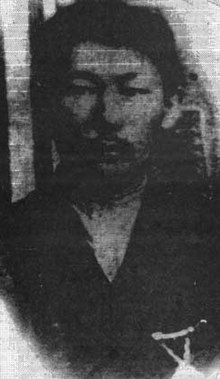| This article needs additional citations for verification. Please help improve this article by adding citations to reliable sources. Unsourced material may be challenged and removed. Find sources: "Mikhail Artemyev" – news · newspapers · books · scholar · JSTOR (January 2019) (Learn how and when to remove this message) |
| Mikhail Artemyev | |
|---|---|
| Михаил Константинович Артемьев | |
 | |
| Born | November 1888/1889/1894 Betyunsk Nasleg, Boturussky Ulus, Yakutsk Oblast, Russian Empire |
| Died | March 27, 1928 (aged 39/38/33) Yakutsk, Yakut ASSR |
| Cause of death | Execution |
| Nationality | Yakut |
| Known for | one of the leaders of the Tungus Republic |
| Criminal charge | Article 59, paragraph 3 of the Criminal Code of the RSFSR |
| Criminal penalty | Execution |
| Father | Konstantin Artemyev |
Mikhail Konstantinovich Artemyev (November 1888 – March 27, 1928) was a participant in the Russian Civil War. He was also the leader of several uprisings against Soviet power in the Eastern Siberia region.
Early life
He was born in November 1888 in a poor peasant family. He graduated from the 4th grade of the Yakut Real School. First, he worked as a clerk in his native nasleg, then as a clerk in the 1st Amginsky district council, as a warden in the Bethunskoy Nasleg, a foreman in the Uranai and Bethuns tribal administrations, and a teacher in the Amga settlement.
Military career
An active participant in the Russian Civil War, Artemyev was initially on the side of the Bolsheviks. On March 17, 1920, the Yakut Revolutionary Headquarters of the Red Army appointed him as the Commissioner of the parish. On March 15, 1920, he was re-appointed as the chairman of the Revolutionary Committee. At the same time, he continued teaching at various educational institutions in Yakutia. He became gradually disappointed in the Soviet regime.
In 1922, he fled from Yakutsk and joined the rebel army Korobeynikov and joined the Yakut revolt. After the failure of the revolt, he hid with his squad in the taigas. In early 1923, he joined the army of General Anatoly Pepelyayev, with whom he served as leader of the White Guerrilla units. After the defeat of Pepelyayev in March 1923, he again hid in the taiga, and participated in the Tungus Uprising from 1924 until 1925, which established the Provisional Tungus Central National Government. He became one of the detachment commanders.
The uprising ended with a peace agreement between the leaders of the uprising and representatives of the leadership of the Yakut Autonomous Soviet Socialist Republic. Artemyev and his detachments laid down their arms on May 9, 1925. In accordance with the agreement, was amnestied. Prior to the beginning of 1927, he was in the Soviet service (secretary of the Nelkan parish, guide and translator), took up housekeeping.
In 1927, he went underground, with the beginning of the movement "confederalists" joined the rebel army of Ksenofontov. In October, he was elected chief of staff of a partisan detachment. In January 1928, he voluntarily surrendered to the Red Army, after which he was tried and sentenced to death by firing squad. The sentence was carried out on March 27, 1928, in Yakutsk.
On October 11, 1999, by the decision of the Prosecutor's Office of the Sakha Republic, Artemyev was posthumously rehabilitated.
References
- Alekseev, Egor (1991). "Кто Вы, Артемьев?". ilin-yakutsk.narod.ru. Ilin. Retrieved December 14, 2018.
- Piskunov, Sergey (January 20, 2000). "Якутские восстания в СССР ("Yakut uprisings in the USSR")". www.hrono.ru. Retrieved December 14, 2018.
- Kharlampiev, Valeriy. "Им возвращено доброе имя ("Their good name has been restored")". www.sitc.ru. Yakutia. Archived from the original on March 11, 2007. Retrieved December 14, 2018.